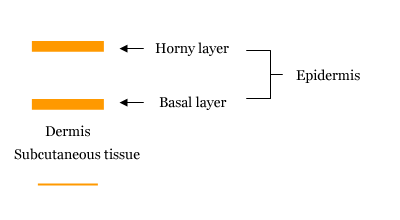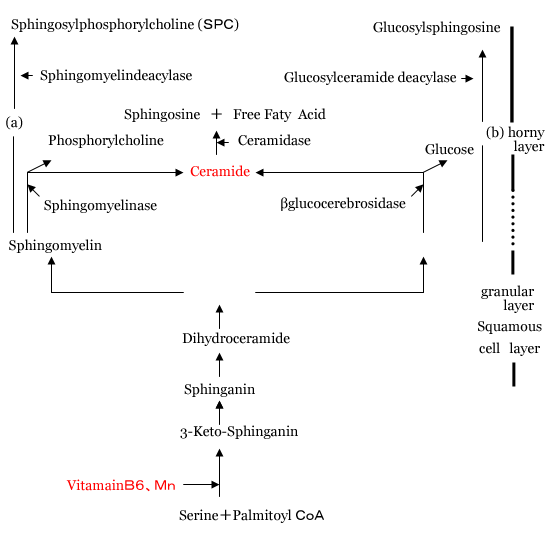Therapeutic Prescriptions by Vitaminx & Minerals
V. Dry skin care
Even though the main symptoms of AD will be cured through treatment, dry skin may persist. Many patients end up not being able to stop using Vaseline and moisturizing cream.
A basic model of the skin is shown below. The horny layer is at the top of the skin, which is made of horny cells full of keratin fibers. These cells contain a lipid, ceramide, which has a high moisture possession capacity. However, AD patients have less ceramide in their skin, and instead have lipids, such as Sphingosylphosphorylcholine (SPC) and Glucosylsphingosine, that have a low moisture possession capacity. When there are too many SPC lipids, the horny layer will harden and become sensitive to slight irritations, and the layer will lose its function as a barrier.

Ceramide is the Prickle layer, Horny layer, and Granular layer of the basal epidermal layer, and is synthesized from amino acids, Serine and Palmitoyl CoA (look at the metabolism chart). Once it accumulates and becomes Glucosylceramide and Sphingomyelin, it will be excreted from the bottom of the Horny layer. These will be converted back to Ceramide by βglucocerebrosidase or Sphingomyelindeacylase in the Horny cells, and will become a thin coat, lamella, when combined with other lipids.
This coat is important for moisturizing the skin. The remaining Ceramide will be hydrolyzed to Sphingosine and Free Fatty Acids. In the case of xerosis senilis, the Ceramide will become more active with increasing age, so there will be less Ceramide, and the skin will dry up. AD, however, does not effect the activity of Ceramidase, Sphingomyelinase, and βglucocerebrosidase.
AD patients, on the other hand, suffer from high Glucosylsphingosine levels induced from high Glucosylceramide deacylase activity. In addition, since the Glucosylceramide deacylase is so active, the βglucocerebrosidase will have to compete with it, which decreases Acylglucosylceramides, a key ingredient in the skin’s barrier. The skin will also produce more Sphingosylphosphorylcholine than Ceramide since the activity of Sphingomyelindeacylas is unnaturally high, which makes it compete with Glucosylceramide deacylase as well. As a result, the combination of reactions (a) and (b) will yield less Ceramide (If you’ve actually read everything to this point, give yourself a pat on the back!! Don’t, worry; you do not need to understand all the medical terms). Simply put, for all the reasons stated above, AD patients have less Ceramides which makes the skin’s moisturizing abilities abysmal.

Mn=Manganese
I’d like to suggest Ceramide containing creams for moisturizing, but Ceramide is made within the skin, and this sort of cream will only have a temporary effect. Even taking in Ceramide orally will not be effective since digestive enzymes in the intestine will break it down.
Look at the chart above. Ceramide is made from Serine and Palmitoyl CoA, but 3-Keto-Sphinganin is needed in the first step. The production of 3-Keto-Sphinganin requires Vitamin B6 and Manganese; without these two nothing will be produced. Selenium, an Amino Acid, and palmitic acid, a saturated fatty acid and an ingredient of Palmitoyl CoA, can be taken in through a normal diet. The required amount of Vitamin B6 per day is 50 mg (which can be taken through supplements) and the required amount of Manganese is 3mg, about the same amount in one cup of pineapple juice.
This is information obtained from Dr. Makise’s having cured atopic dermatitis of 40,000 people or more in total and the latest and highest atopic dermatitis treatment. But this is provided for information only. No action should be taken based solely on the contents of this website; instead, readers should consult appropriate health professionals on any matter relating their health. Readers who fail to consult with appropriate health authorities assume the risk of any injuries. Dr. Makise is not responsible for errors or omissions.
If you have any questions or inquires, or if you would like to order the supplements or ointments, please click here. >>
Copyright: No reproduction or republication without written permission.
